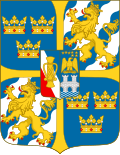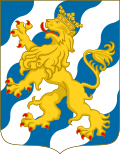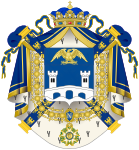Coat of arms of Sweden
| Greater coat of arms of the Kingdom of Sweden | |
|---|---|
 | |
| Versions | |
 Version without the ermine mantling | |
 Version without the ermine mantling, the compartment and the supporters | |
 Version consisting of the crowned escutcheon only | |
| Armiger | Carl XVI Gustaf The King of Sweden |
| Adopted | 1448 November 17, 1905 |
| Crest | Royal Crown of Sweden |
| Shield | Azure, quartered by a cross Or with outbent arms, and an inescutcheon containing the dynastic arms of the Royal House. In the first and fourth fields three open crowns Or, placed two above one. In the second and third fields three sinisterbendwise streams argent, a lion crowned with an open crown Or armed gules. The inescutcheon is party per pale the arms for the House of Vasa (Bendwise azure, argent and gules, a vasa (sheaf of wheat) Or); and the House of Bernadotte (Azure, issuant from a wavy base a bridge with three arches and two towers embattled argent, in honour point an eagle regardant with wings inverted resting on thunderbolts Or, and in chief the Big Dipper constellation of the same). |
| Supporters | two lions regardant, crowned and with forked tails (queue fourchée) Or armed gules, standing on a compartment Or |
| Compartment | Pedestal Or |
| Order(s) | Order of Seraphim |
| Other elements | All surrounded by ermine mantling, crowned with a royal crown and tied up with tasseladorned strings Or |
| Lesser coat of arms of the Kingdom of Sweden | |
|---|---|
 | |
| Versions | |
 Version without the Order of the Seraphim | |
| Armiger | The Riksdag Government of Sweden King of Sweden |
| Adopted | 1336[1] November 17, 1905 |
| Crest | Royal Crown of Sweden |
| Shield | Azure, three coronets Or, placed two above one |
| Order(s) | Order of Seraphim |
The coat of arms of the Kingdom of Sweden (Template:Lang-sv) has a lesser and a greater version.
Regulated usage
The usage of the coats of arms is regulated by Swedish Law, Act 1970:498, which states (in unofficial translation) that "in commercial activities, the coats of arms, the flag or other official insignia of Sweden may not be used in a trademark or other insignias for products or services without proper authorisation. This includes any mark or text referring to the Swedish State which thus can give the commercial mark a sign of official endorsement. This includes municipal coats of arms which are registered."
Any representation consisting of three crowns ordered two above one are considered to be the lesser coat of arms, and its usage is therefore restricted by law 1970:498.
Variants
Greater version
The greater coat of arms is blazoned in Swedish law as follows:
A shield azure, quartered by a cross Or with outbent arms, and an inescutcheon containing the dynastic arms of the Royal House. In the first and fourth fields three open crowns Or, placed two above one. In the second and third fields three sinisterbendwise streams argent, a lion crowned with an open crown Or armed gules. The inescutcheon is party per pale the arms for the House of Vasa (Bendwise azure, argent and gules, a vasa Or); and the House of Bernadotte (Azure, issuant from a wavy base a bridge with three arches and two towers embattled argent, in honor point an eagle regardant with wings inverted resting on thunderbolts Or, and in chief the Big Dipper constellation of the same). The main shield is crowned by a royal crown and surrounded by the insignia of the Order of the Seraphim. Supported by two lions regardant, crowned and with forked tails Or armed gules, standing on a compartment Or. All surrounded by ermine mantling, crowned with a royal crown and tied up with tasseladorned strings Or.[2]
The greater arms may also be displayed only with the crowned escutcheon. While the arms have undergone significant changes over the years, such as changing the inescutcheon with the ruling dynasty, they are based on arms created by King Karl Knutsson in 1448.[3]
The escutcheon used in the greater blazon has in total five elements: 4 quarterings on the main escutcheon (two coats of arms duplicated), and three coat of arms incorporated into an escutcheon of pretense. However, Bernadotte never used any stars in the arms of Pontecorvo (neither as Prince of Pontecorvo, nor as King of Sweden and Norway) contrary to the illustration below. The stars were introduced as an element in the royal coat of arms in the 19th century,[4] chosen as a symbol of Sweden's eternal existence, as in the poem by Esaias Tegnér:
As long as Charles's Wain still turns
Its golden wheels around the Northern zone
Intact shall stand the ancient Swedish throne.
This symbol became especially popular through its allusion to the name that had been borne by so many famous Swedish kings. Charles's Wain, or as it is called in Swedish, Karlavagnen, adds a Swedish accent to the Bernadotte dynastic coat of arms much in the same way as do the Vasa arms.[5]
 | |||||||||||||||||||||
 The three crowns |  House of Bjelbo |  House of Bernadotte | |||||||||||||||||||
 The House of Vasa |  Arms of Jean Baptiste Jules Bernadotte as prince of Ponte Corvo and Marshal of France (later Charles XIV of Sweden) | ||||||||||||||||||||
 Napoleon I |  Ponte Corvo | ||||||||||||||||||||

The arms are supported by two lions with forked tails (queue fourchée), facing away from the shield and crowned with Royal Crowns. For centuries, the lion has been an important element in Swedish heraldry and especially for the State Coat of Arms. The shield may be surmounted by the Collar of the Order of Seraphim, the foremost order in Sweden, and the highest honour the Swedish state can bestow on an individual.[6]
Besides being the official national coat of arms, the greater coat of arms is also the personal coat of arms of the king, and as such he can decree its use as a personal coat of arms by other members of the Royal House, with the alterations and additions decided by him.
Blazon: "The greater state arms consist of a head shield azure, quartered by a cross or with outbent arms, and an inescutcheon containing the dynastic arms of the Royal House.
In the first and fourth fields three coronets or, placed two above one. In the second and third fields three sinisterbendwise streams argent, a lion crowned with an open crown or with armaments gules. The inescutcheon is party per pale the arms for the House of Vasa and the House of Bernadotte. The main shield is crowned by a royal crown and surrounded by the insignia of the Order of the Seraphim. Supported by two lions regardant or crowned, with parted tails and armaments gules, standing on a postament. All surrounded by hermine mantling crowned with a royal crown and tied up with tasseled strings or."
Lesser version
The lesser coat of arms is mainly used by the Government of Sweden and subordinate government authorities. As such it may be joined by insignias symbolising the activity of individual government agencies, following approval by the State Board of Heraldry. It is, for instance, embroidered on all Swedish police uniforms and in various coats of arms of the Swedish Armed Forces.
Blazon: "Azure, with three coronets Or, ordered two above one." Crowned with a royal crown. The shield may also be surrounded by the insignias of the Order of the Seraphim."
Royal Family
See also
References
- ^ Loÿe, Georges de (1986). "Om ursprunget till det svenska riksvapnet Tre Kronor". Heraldisk tidsskrift (in Swedish). 1986(6):54, : 155–174 : ill. ISSN 0440-6966. 0440-6966.
{{cite journal}}: CS1 maint: extra punctuation (link) - ^ Original text of Swedish statute 1982:268, 2 §, states: Stora riksvapnet utgörs av en blå huvudsköld, kvadrerad genom ett kors av guld med utböjda armar, samt en hjärtsköld som innehåller det kungliga husets dynastivapen. Huvudsköldens första och fjärde fält innehåller tre öppna kronor av guld, ordnade två över en. Huvudsköldens andra och tredje fält innehåller tre ginbalksvis gående strömmar av silver, överlagda med ett upprest, med öppen krona krönt lejon av guld med röd tunga samt röda tänder och klor. Hjärtskölden är kluven. Första fältet innehåller Vasaättens vapen: ett i blått, silver och rött styckat fält, belagt med en vase av guld. Andra fältet innehåller ätten Bernadottes vapen: i blått fält en ur vatten uppskjutande bro med tre valv och två krenelerade torn, allt av silver, däröver en örn av guld med vänstervänt huvud och sänkta vingar gripande om en åskvigg av guld samt överst Karlavagnens stjärnbild av guld. Huvudskölden är krönt med en kunglig krona och omges av Serafimer ordens insignier. Sköldhållare är två tillbakaseende, med kunglig krona krönta lejon med kluvna svansar samt röda tungor, tänder och klor. Lejonen står på ett postament av guld. Det hela omges av en med kunglig krona krönt hermelinsfodrad vapenmantel av purpur med frans av guld och uppknuten med tofsprydda snören av guld. Stora riksvapnet får brukas även utan ordensinsignier, sköldhållare, postament eller vapenmantel. "Lag (1982:268) om Sveriges riksvapen". Swedish Code of Statutes (in Swedish). Sveriges Riksdag. 1982-04-29. Retrieved 2008-06-27.
- ^ "Stora riksvapnet" (in Swedish). Swedish National Archives. 2011-12-20. Retrieved 2012-01-29.
- ^ Berghman, Arvid (1944). Dynastien Bernadottes vapen och det svenska riksvapnet. Skrifter / utgivna av Riksheraldikerämbetet, 99-2298099-1 ; 1 (in Swedish). Stockholm: Svensk litteratur.
- ^ http://www.theheraldrysociety.com/articles/early_history_of_heraldry/the_three_crowns_of_sweden.htm
- ^ See sections 2 and 3, Lag No. 268 om Sveriges Riksvapen of April 29, 1982.











